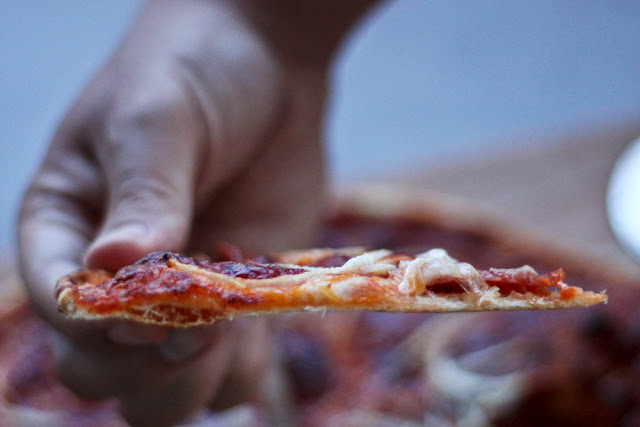Perfect Prime Rib
Who wants to make a fancy pants meal that is insanely easy?!? Excellent, let me show you just how simple it is to make phenomenal prime rib at home!
 |
| Prime rib with a side of potato al forno and mushrooms sautéed in butter and sweet vermouth |
Now I'm not going to get into all the nitty gritty of why you should reverse sear your prime rib (great crust with evenly cooked meat) or why you should salt your prime rib at least one day in advance (deeper flavor and better crust). If you want to read more about all of the whys of a great prime rib I highly recommend you read the Serious Eats and Cooks Illustrated articles on these topics.
Instead, I'm just going to simply share with you how easy it is to make a great prime rib at home. Because in the end all you need is some meat and salt (and a meat thermometer).
 |
| Salted the roast and getting it ready for its overnight nap in the fridge |
Oh, and and time. Time is very important for this recipe. Because first you need to salt your roast and let it chill out in the fridge for a day (or four). This will season the meat and intensify the flavor of your roast.
 |
| This is the roast after one day in the fridge. You can see how the color has deepened from the photo above. |
Then you need to slowwwwwwwly cook your roast in the oven so its super duper tender and evenly cooked. After its cooked to your liking, the meat rests for a bit, and during this time you can bake any side dishes you have to prep, like my potato and leek al forno. Finally, a quick trip in a hot oven right before you're ready to serve provides the final "sear" on the cooked roast.
My recipe below is a bit of a hybrid from techniques I learned from SE and CI. If you'd like to sear your meat first (I didn't), check out the CI recipe linked below. They also have you turn off the oven and let residual heat finish cooking the roast for those last 10 degrees. It sounded interesting but we were impatient and just cooked the roast all the way using the SE technique.
Yours in showing you that a fancy steakhouse meal at home is not as crazy as you think,
Jacqueline
Perfect Prime Rib, adapted from Serious Eats and Cooks Illustrated (full recipe here)
Notes: To keep the bone or not to keep the bone... that is the question. While the rib bones help protect meat from overcooking and provide flavor, they inhibit the seasoning and make carving the prime rib more difficult. So the geniuses at Cooks Illustrated recommend cutting the bones off the meat before seasoning, and tying them back on before roasting. The Serious Eats recipe leaves the bone in, so you do you. Just remember, you'll want to start the roast at least one day before cooking, and up to 4 days beforehand to deepen the flavor.
Ingredients
2- or 3-bone rib roast, bone-in (I believe ours was 2 bones because it weighed about 4.8 lb; a 3-bone roast will probably weigh around 7-8 pounds)
Diamond kosher salt* (just under 1.5 TBSP for a 2-bone roast and ~2 TBSP for a 3-bone roast)
pepper, to taste
*Yes, the brand of salt really matters! Here's a quick conversion for you: 3 tsp Diamond kosher = 1 ½ tsp Morton kosher = 1 ⅛ tsp table salt
Directions
- Prepare the rib roast (1-4 days before cooking). Remove bones: Using a sharp knife, remove the bones from the roast, running the knife down the length of the bones, following the contours as closely as possible until the meat is separated. Do not discard the bones.
Score fat cap: Cut slits in the fat spaced one inch apart in a crosshatch pattern. Be sure to cut all the way through the fat but do not cut into the meat.
Season the roast: Rub a generous amount of kosher salt and pepper all over the roast and into the slits of the fat cap.
Tie bones back on and chill in the fridge: Place the meat back on the bones and tie together with kitchen twine. Place on a wire rack set in a rimmed baking sheet and refrigerate uncovered (fat cap up) at least 24 hours, and up to 96 hours (to dry out the surface of the roast and season the meat). - Bake rib roast. Adjust oven rack to middle position and heat oven to 200 degrees. Place the roast in oven and cook until center of roast registers 120-125°F (49-52°C) on an instant-read thermometer for rare, 130°F (54°C) for medium-rare, or 135°F (57°C) for medium to medium-well. I cooked our roast to 125°F, which took just under 4 hours.
- Rest the meat. Remove roast from oven and tent loosely with aluminum foil. Place in a warm spot in the kitchen and allow to rest for at least 30 minutes and up to 1 1/2 hours.
- "Sear" the roast in the oven. Preheat oven to highest possible temperature setting, 500 to 550°F (260 to 288°C). Ten minutes before you are ready to eat, remove foil, place roast back in hot oven, and cook until well-browned and crisp on the exterior, 6 to 10 minutes. (Note: you can also broil the roast for 4 to 8 minutes until browned.)
- Serve. Transfer the roast to a carving board, cut the twine, and remove the meat from the rib. Slice into 3/4 inch thick slices, season with salt, and serve.






Comments
Post a Comment